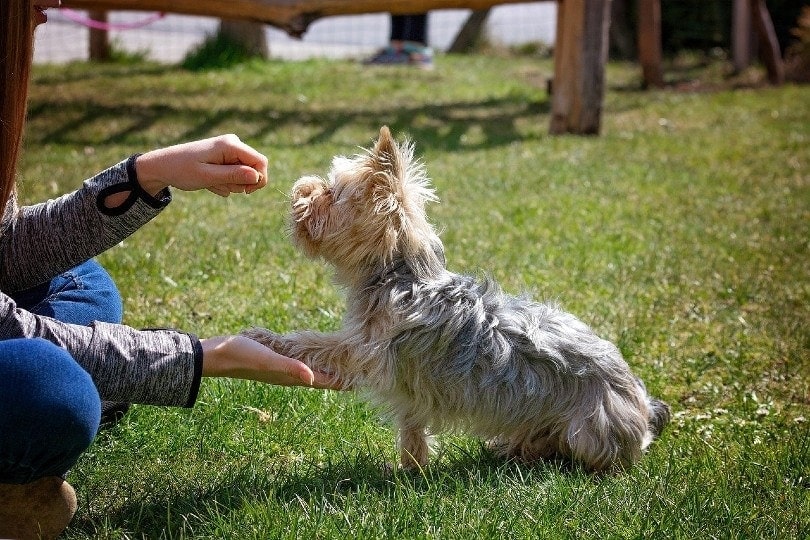How to Stop a Dog from Barking at Noises: 5 Vet Approved Tips

Updated on

Expecting a dog to not bark goes against their nature. Barking is a way for them to communicate. Although, some dogs bark at every little noise. It is annoying for the owner, but a dog’s excessive barking can also upset your neighbors or cause problems with your landlord.
Barking, among other things, is a way for your dog to communicate. Dogs have distinctive barks, and most times, we can identify them. A dog may have a particular bark for greeting people and another bark for alerting us to strange animals or things. But do we really know “why” they are barking? You may think they bark just to be heard, but that isn’t necessarily the case.
Why Do Dogs Bark?
- To be territorial or protective: The dog gets louder as the threat gets closer.
- Out of fear: If they hear a noise or something catches them by surprise, they will bark.
- When they are bored: Loneliness and lack of stimulation will cause a dog to bark.
- To greet: It’s a way to say hello and be social.
- To get attention: Dogs use it to let you know they need or want something, such as going outside or getting a treat.
- Suffering from separation anxiety: Dogs who are left alone for long periods may become excessive barkers.
The 5 Tips to Stop a Dog from Barking at Noises
1. Take a Trip to the Vet
In some cases, sensitivity to sound can be caused by other conditions, like separation anxiety. Your best bet is to talk to your vet. You may be able to address the noise anxiety with a behaviorist or professional trainer. In some instances, if the condition is severe, the dog may require anti-anxiety medication along with training.

2. Identify Upsetting Sounds
First, identify the noises that your dog reacts to most often. The easiest way to stop your dog from barking at unfamiliar noises is to narrow it down to which noises in particular may be causing your dog’s anxiety.
A dog’s specific noise anxiety can escalate to the point of barking at every little noise. They may start by reacting to fireworks and, over time, start to react to everyday noises that other dogs ignore.
3. Desensitization or Changing the Volume
Is your dog barking every time he hears the opening of the mailbox or the neighbor opening the door of his car? If this is the case, you will need to use positive desensitization.
If you are friendly with the neighbor, ask them to text you when leaving the house. You can then sit with the dog and as the neighbor is opening doors and making noise, start feeding the dog treats and softly talk to the dog. Continue to give him treats until the noise stops. If the dog starts to bark, stop giving him treats.
Repetition is key to getting the dog to understand. You may want to ask the neighbor to engage, allowing the dog to get to know them. The dog will eventually associate the neighbor’s noise making with something positive, getting treats.
If your canine is reacting to regular household noises, you can desensitize your dog by controlling the volume of the offensive noise. Adjust the volume of the radio or TV to a low level while giving him treats. The dog will associate the noise with something positive, allowing you to increase the volume over time.

4. Increase Activity
Boredom and excess energy can lead to anxious barking. You decrease a dog’s pent-up energy by simply taking him for a walk or playing a game of fetch. If you and your canine are stuck indoors, play a game of hide-and-seek or give him a treat puzzle to release some energy.
5. Use of Commands
A command can be a sound, sign, or gesture. Dogs respond well to them.
Patience and consistency are the keys. Do not give a command and walk away. When giving the dog a command, you must calmly continue to give the command until the behavior stops.
Teaching your dog to bark on command works in the opposite direction. When you tell your dog to “speak” and he responds, give him a treat. Once he learns to speak on command, you can teach “Quiet” by giving him a treat when they stop barking. As the dog learns what you want from him, you will no longer need the treats.

Here Are Some Things Not to Do
- Don’t yell at the dog. – When you yell at a dog for barking, he thinks you are joining him. Instead of discouraging bad behavior, you are encouraging and rewarding him. Yelling at the dog could also scare them.
- Don’t be inconsistent. – Inconsistency causes confusion. Everyone living in the home needs to be on the same page. Don’t encourage behavior one day and discourage it the next. It is also equally important for everyone in the home to use the same commands.
- Don’t forget to practice. – Practice, practice, practice. Teaching commands for small amounts of time every day will prepare your dog for real-life situations.
- Don’t expect him to learn immediately. – Dogs like to bark, and habits are hard to break. The longer the bad behavior is allowed, the more time it will take to undo it. It may take weeks or months to re-train your dog but don’t give up. Your dog wants to please.
- Don’t make it more difficult. – If your dog barks at every animal, person, or thing moving past your home, remove it. Since we cannot remove our neighbors or their pets, we need to remove our pet’s ability to see them. For instance, close the windows or blinds or put them in a room without easy access to them. If they are out of sight, they won’t bark.
Conclusion
You will need to be patient and consistent. Teaching your pet “appropriate” barking may not be easy but with time and the proper techniques, you and your little buddy can conquer this challenge together.
Featured Image Credit: cynoclub, Shutterstock














